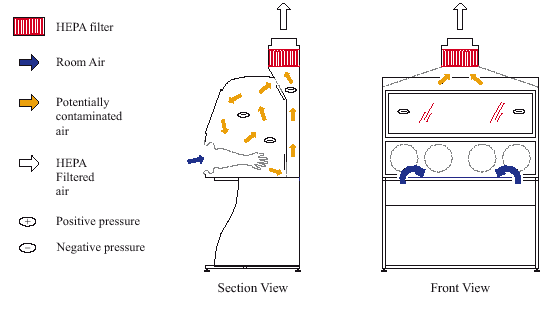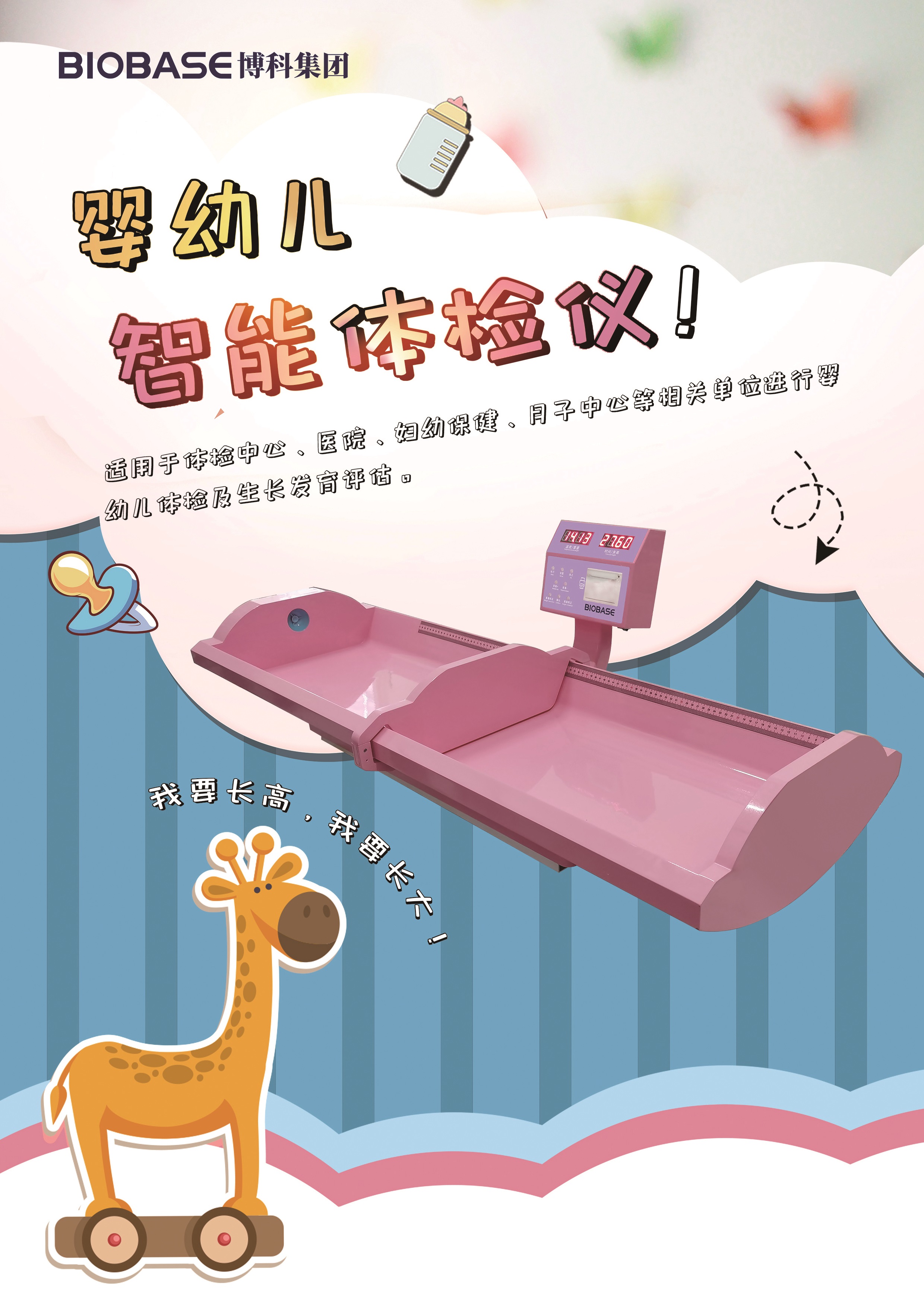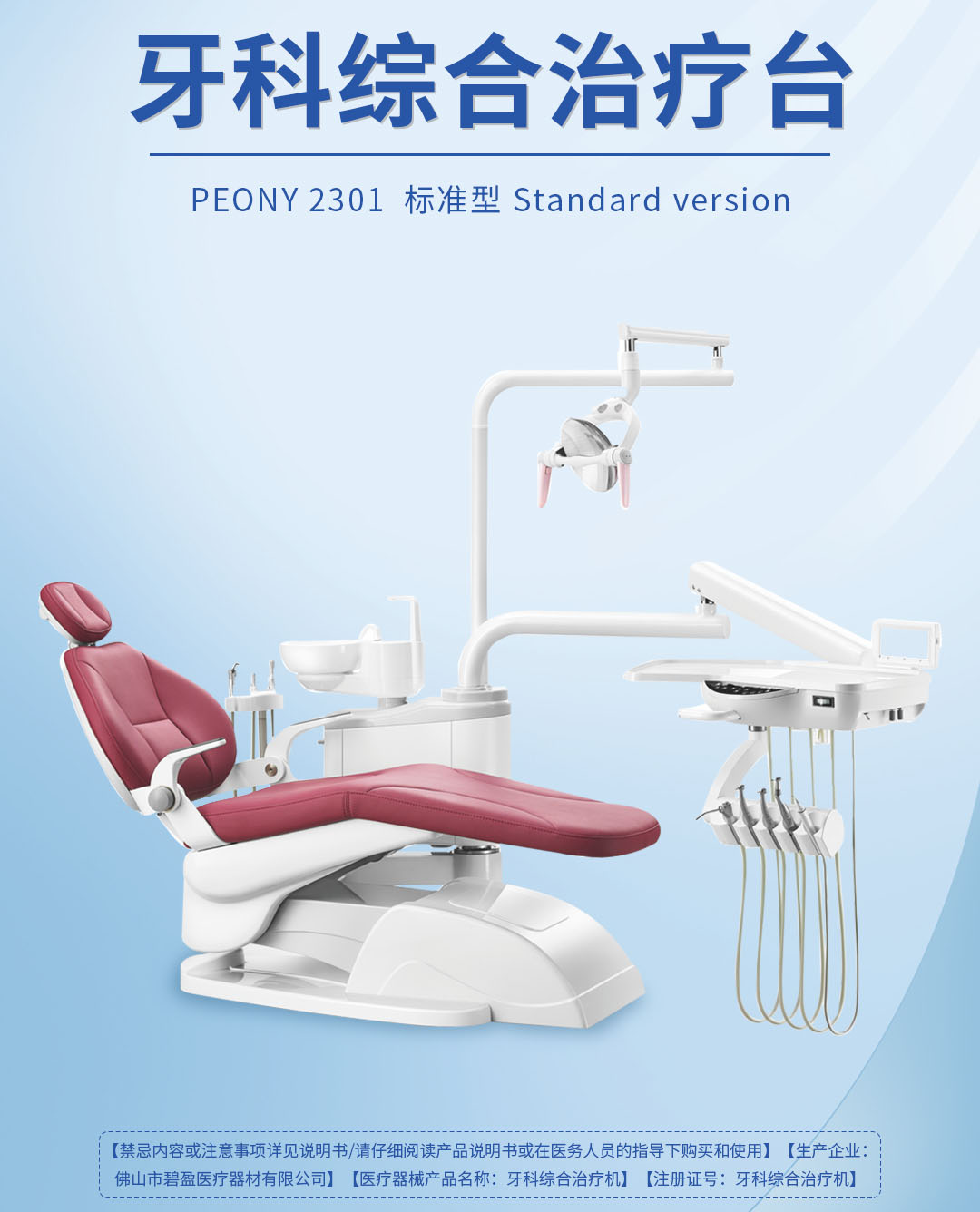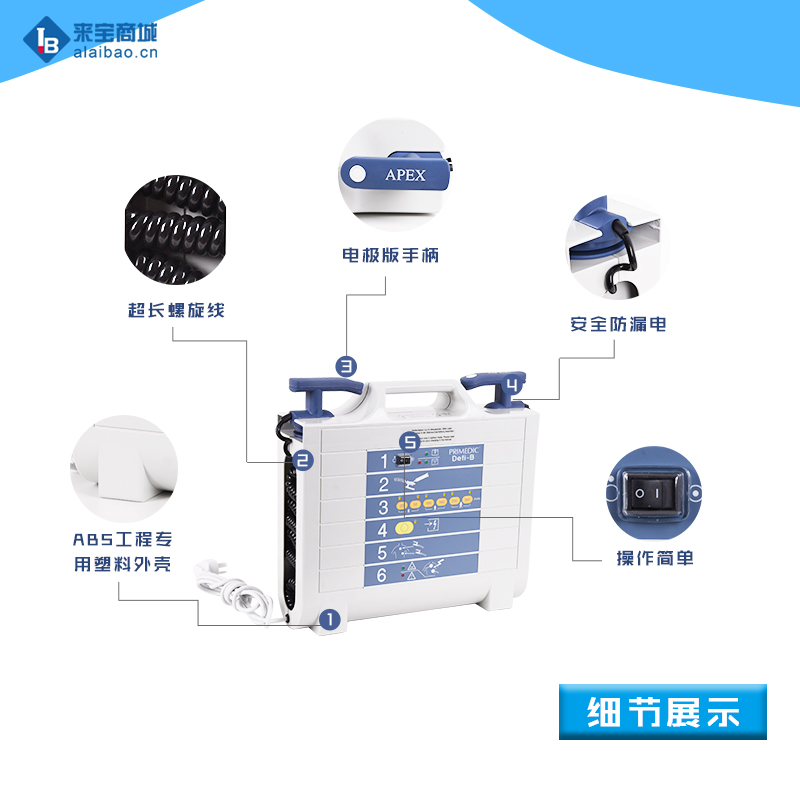生物安全柜工作原理示意图
- CDC2008年1月17日 22:14 点击:23072
生物安全柜:是为操作原代培养物、菌毒株以及诊断性标本等具有感染性的实验材料时,用来保护操作者本人、实验室环境以及实验材料,使其避免暴露于上述操作过程中可能产生的感染性气溶胶和溅出物而设计的。生物安全柜可提供样品和工作人员的双重保护。


Class II Type A1 BSC Characteristics
Exhaust approximately 30% of total air handled and recirculate 70% in cabinet
Minimum inflow air velocity is 75 fpm (0.38 m/s) through the front opening
May exhaust HEPA filtered air back into the room or through a canopy (to the outdoors)
Audiovisual alarm required when connected to a building exhaust system
May have contaminated ducts and plenums under positive pressure to the room
Type A1 cabinets are not suitable for work with volatile toxic chemical and volatile radionuclides.
生物安全柜工作原理示意图-图片说明:
Class II Type A1 BSC Characteristics Exhaust approximately 30% of total air handled and recirculate 70% in cabinet Minimum inflow air velocity is 75 fpm (0.38 m/s) through the front opening May exhaust HEPA filtered air back into the room or through
Biological Safety Cabinets
9.1 Introduction
When properly maintained and used in conjunction with good laboratory techniques, BSCs provide effective primary containment for work with human pathogens. In containment level 2 facilities, BSCs are used for procedures with the potential to produce infectious aerosols and for high concentrations or large volumes of infectious material. In containment levels 3 and 4, all open vessel activities with infectious materials are conducted in a BSC. Every employee working in a BSC must be trained in its correct use and have a good understanding of the different types of cabinets and how they work. Detailed information on the selection, function, and use of BSCs can be found elsewhere in the literature(1-3).
9.2 Classes and Characteristics of Biological Safety Cabinets
There are three classes of BSC: Class I, Class II and Class III. Selection of the proper class of BSC requires careful evaluation of the activities to be carried out. Horizontal, clean benches that direct air towards the operator are not biological safety cabinets and must not be used for handling infectious, toxic or sensitizing materials. Only cabinets that meet the National Sanitation Foundation (NSF) Standard No. 49-2002 (independent standard for the design, manufacture and testing of BSCs) and bear an NSF 49 seal should be purchased(4).
Class I Cabinets (Figures 1a and 1b)
These cabinets have unrecirculated airflow away from the operator that is discharged to the atmosphere after filtration through a HEPA filter. They provide good operator protection but do not protect the material within the cabinet (the product) from contamination.
Class II Cabinets (Figures 2-5)
Class II cabinets are designed for personnel, product and environmental protection. They are designed for work involving microorganisms in containment levels 2, 3 and 4 laboratories and are divided into two types (A and B) on the basis of construction type, airflow velocities and patterns, and exhaust systems(4).
Within type (A), there are two subtypes, A1 (formerly designated type A) and A2 (formerly designated type B3). Within type (B), there are two subtypes, B1 and B2. Class II cabinets are most commonly used in biomedical research laboratories because of their characteristics.
Class II, Type A1 Cabinets (Figure 2)
- Cabinet air may be recirculated back into the laboratory or ducted out of the building by means of a "thimble" connection (i.e., a small opening around the cabinet exhaust filter housing) whereby the balance of the cabinet is not disturbed by fluctuations in the building exhaust system. The thimble must be designed to allow for proper certification of the cabinet (i.e., provide access to permit scan testing of the HEPA filter).
- Maintain a minimum average face velocity of 0.38 m/s (75 ft/min).
- May have positive pressure contaminated ducts and plenums.
- Are not suitable for work with low levels of volatile toxic chemicals and volatile radionuclides(4).
Class II, Type A2 Cabinets (Figure 3)
- Cabinet air may be recirculated back into the laboratory or ducted out of the building by means of a "thimble" connection (i.e., a small opening around the cabinet exhaust filter housing) whereby the balance of the cabinet is not disturbed by fluctuations in the building exhaust system. The thimble must be designed to allow for proper certification of the cabinet (i.e., provide access to permit scan testing of the HEPA filter).
- Maintain a minimum average face velocity of 0.5 m/s (100 ft/min).
- Have ducts and plenums under negative pressure.
- Is suitable for work with minute quantities of volatile toxic chemicals and trace amounts of radionuclides.
Class II, Type B1 Cabinets (Figure 4)
- Hard-ducted through a dedicated duct exhausted to the atmosphere after passage through a HEPA filter; contain negative pressure plena.
- Maintain a minimum average face velocity of 0.5 m/s (100 ft/min).
- Recirculate 30% of the air within the cabinet.
- Suitable for work with low levels of volatile toxic chemicals and trace amounts of radionuclides.
Class II, Type B2 Cabinets (Figure 5)
- Does not recirculate air within the cabinet.
- Maintain a minimum average face velocity of 0.5 m/s (100 ft/min).
- Hard-ducted through a dedicated duct exhausted to the atmosphere, 100% of cabinet air, after passage through a HEPA filter; contain negative pressure plena.
- Suitable for work with volatile toxic chemicals and radionuclides.
The exhaust canopy must allow for proper BSC certification. An alarm should be provided that is audible at the cabinet to indicate loss of exhaust flow from the building exhaust system. The cabinet internal fan should also be interlocked to shut down when the building exhaust system fan fails, to prevent pressurization of the cabinet.
Class III Cabinets (Figure 6)
Class III cabinets are totally enclosed and gas-tight with HEPA filtered supply and exhaust air. Work is performed with attached long-sleeved gloves. The cabinet is kept under negative pressure of at least 120 Pa (0.5 in. w.g.), and airflow is maintained by a dedicated exterior exhaust system. Class III cabinets protect the worker and the product. They are designed for work with level 4 pathogens and provide an alternative to the positive-pressure suit made for maximum containment laboratories. Cabinet lines consisting of several Class III cabinets (e.g., for centrifuges, animal cages, incubators, refrigerators) and transfer devices joined together are traditionally custom built. Specific guidance on the unique requirements for constructing, installing, certifying and using Class III cabinet lines can be found elsewhere(5-7). The exhaust air is double HEPA filtered or treated by HEPA filter and incineration. Removal of materials from the cabinet must be through a dunk tank, double door autoclave or air-lock pass-through for decontamination. Interlock or protocols must be used for the autoclave and pass-through doors to prevent both doors from being open at the same time.
9.3 Installation and Certification
The air curtain at the front of the cabinet is fragile and can easily be disrupted by people walking parallel to it, by open windows, air supply registers or laboratory equipment that creates air movement (e.g., vacuum pumps, centrifuges). BSCs should be installed in accordance with the requirements outlined in the Canadian Standards Association (CSA) Biological Containment Cabinets (Class I and II): Installation and Field Testing(8). They should be located away from high traffic areas, doors and air supply/exhaust grilles that may interrupt airflow patterns. A minimum unobstructed distance of 40 cm should be provided between the exhaust outlet on top of the cabinet and any overhead obstructions. Whenever possible, a 30 cm clearance should be provided on each side of the cabinet to allow for maintenance access. For ducted cabinets, blowers on the exhaust system should be located at the terminal end of the ductwork; failure of exhaust flow should signal an alarm to the user. To prevent pressurization of the cabinet, an interlock system should be installed to prevent the cabinet blower from operating whenever the exhaust flow is insufficient; an anti-backflow device to prevent reverse airflow through the HEPA filter may be required.
Continuous operation of BSCs helps to control dust levels and other airborne particulates in the laboratory. If BSCs are operated only when needed in order to conserve energy, the balancing of laboratory room air must be considered. In some cases, room exhaust is balanced to include the air exhausted through ducted BSCs, and these cabinets must not be turned off.
The provision of natural gas to BSCs is not recommended. Open flames in the BSC create turbulence, disrupt airflow patterns and can damage the HEPA filter(1). When suitable alternatives (e.g., disposable sterile loops, micro-incinerators) are not possible, touch-plate microburners that have a pilot light to provide a flame on demand may be used.
The correct operation of BSCs must be verified before they are used and then annually, and after any repairs or relocation, in accordance with the field tests outlined in CSA Z316.3-95 or annex F of NSF 49. Moving a cabinet can cause damage to the HEPA filter and its seals. These tests include the downward velocity profile, the work access face velocity, the HEPA filter leak test and the airflow smoke patterns. Measuring and testing equipment must be calibrated and maintained in accordance with the CSA standard. A copy of the certification report must be provided to the user and kept on file. A label indicating the date of certification, the date of the next certification, to what standard the tests were performed and the name of the certifier should be affixed to the exterior of the cabinet. On-site field testing must be performed by experienced qualified individuals. The NSF accreditation program for BSC certifiers provides a list of individuals who have demonstrated their competence by means of written and practical examinations administered by the NSF(9). Whenever possible, it is recommended that NSF-accredited field certifiers be used.
9.4 Use of the Cabinet
Follow these start-up procedures when preparing for work in the BSC:
-
Turn off UV lights if in use and ensure that the sash is in the appropriate position.
-
Turn on fluorescent light and cabinet blower, if off.
-
Check the air intake and exhaust grilles for obstructions.
-
If the cabinet is equipped with an alarm, test the alarm and switch it to the "on" position.
-
Confirm inward airflow by holding a tissue at the middle of the edge of the viewing panel and ensuring that it is drawn in.
-
Disinfect the interior surfaces with a suitable, noncorrosive disinfectant.
-
Assemble all materials required for the procedure and load them into the cabinet; do not obstruct the air grilles; the working surface may be lined with absorbent paper with plastic backing; segregate "clean" items from "contaminated" items.
-
Wait 5 minutes to purge airborne contaminants from the work area.
Follow these procedures for working in the cabinet :
-
Don protective clothing and gloves as appropriate.
-
Perform operations as far to the rear of the work area as possible.
-
Avoid movement of materials or excessive movement of hands and arms through the front access opening during use; when you do enter or exit the cabinet, do so from straight on; allow the cabinet to stabilize before resuming work.
-
Keep discarded, contaminated material to the rear of the cabinet; do not discard materials in containers outside of the cabinet.
-
Do not work with open flames inside the cabinet.
-
If there is a spill during use, surface decontaminate all objects in the cabinet; disinfect the working area of the cabinet while it is still in operation (do not turn the cabinet off).
Follow these procedures upon completion of the work :
-
Allow the cabinet to run for 5 minutes with no activity.
-
Close or cover open containers before removing them from the cabinet.
-
Surface disinfect objects in contact with contaminated material before removal from the cabinet.
-
Remove contaminated gloves and dispose of them as appropriate; wash hands.
-
Don clean gloves, and ensure that all materials are placed into biohazard bags within the cabinet.
-
Using a suitable non-corrosive disinfectant (e.g., 70% ethanol), disinfect interior surfaces of cabinet; periodically remove the work surface and disinfect the area beneath it (including the catch pan) and wipe the surface of the UV light with disinfectant.
-
Turn off the fluorescent light and cabinet blower when appropriate (some cabinets must be left on at all times; if you are unsure, check with your cabinet certifier, safety officer or building maintenance personnel).
-
Turn on the UV light if appropriate (do not turn on when people are working close by); UV must be tested to ensure that it is emitting a germicidal wavelength (ask your cabinet certifier to perform this test).
References
-
Centers for Disease Control and Prevention. Primary containment for biohazards: selection, installation and use of biological safety cabinets. Washington, DC: U.S. Government Printing Office, 2000.
-
Kruse, R.H., Puckett, W.H., and Richardson, J.H. Biological safety cabinetry. Clin Microbiol Rev 1991;4:207-41.
-
Stuart, D.G. Primary barriers: biological safety cabinets, fume hoods, and glove boxes. In: Fleming, D.O., and Hunt, D.L. Biological safety principles and practices. Washington, DC: ASM Press, 2000;313-30.
-
NSF International. Class II (laminar flow) biohazard cabinetry. Standard 49. Ann Arbor, Michiganj: NSF International, 2002.
-
Stuart, D.G., Hilliard , J., Kenkel, R., Kelley, J., and Richmond, J. Role of the class III cabinet in achieving BSL-4. In: Richmond, J.Y. Anthology of biosafety I: perspective on laboratory design. Mundelein, IL: American Biological Safety Association, 1999;149-60.
-
National Cancer Institute Office of Research Safety and the Special Committee of Safety and Health Experts. Laboratory safety monograph, a supplement to NIH guidelines for recombinant DNA research. Bethesda, MD: NIH, 1979.
-
Biotechnology – performance criteria for microbiological safety cabinets. BS EN 12469:2000. European Committee for Standardization (CEN), 2000.
-
Biological containment cabinets (class I and II): installation and field testing. Z316.3-95. Canadian Standards Association, Toronto, ON, 1995.
-
NSF International. NSF listings — field certifier accreditation. Ann Arbor, Michigan: NSF International, 2000.
 Fig. 1a. CLASS I BIOLOGICAL SAFETY CABINET (Used in conjunction with the building system. Glove ports are optional.) |
 Fig. 1b. CLASS I BIOLOGICAL SAFETY CABINET (Complete with internal motor/blower assembly. HEPA filtered exhaust air vented to the atmosphere. Glove ports are optional.) |
 Fig. 2. CLASS II TYPE A1 BIOLOGICAL SAFETY CABINET (Can be room re-circulated or air gap type (thimble).) |
 Fig. 3. CLASS II TYPE A2 BIOLOGICAL SAFETY CABINET (Can be room re-circulated or air gap type (thimble).) |
 Fig. 4. CLASS II TYPE B1 BIOLOGICAL SAFETY CABINET (Hard-ducted.) |
 Fig. 5. CLASS II TYPE B2 BIOLOGICAL SAFETY CABINET (Hard-ducted.) |
 Fig. 6. CLASS III BIOLOGICAL SAFETY CABINET (Hard-ducted.) |
联系邮箱:kefu@labbase.net
版权与免责声明
- 凡本网注明“来源:来宝网”的所有作品,版权均属于来宝网,转载请必须注明来宝网, //www.next-search.com,违反者本网将追究相关法律责任。
- 本网转载并注明自其它来源的作品,目的在于传递更多信息,并不代表本网赞同其观点或证实其内容的真实性,不承担此类作品侵权行为的直接责任及连带责任。其他媒体、网站或个人从本网转载时,必须保留本网注明的作品来源,并自负版权等法律责任。
- 如涉及作品内容、版权等问题,请在作品发表之日起一周内与本网联系,否则视为放弃相关权利。







